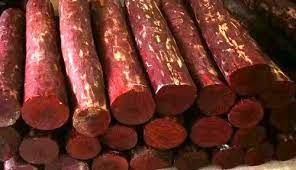CURRENT AFFAIRS
Get the most updated and recent current affair content on Padhaikaro.com
Red Sanders
- Vaid's ICS, Lucknow
- 12, Jan 2022

Why in News?
- Red Sanders (Red Sandalwood) has fallen back into the ‘endangered’ category in the International Union for Conservation of Nature’s (IUCN) Red List.
- It was classified as ‘near threatened’ in 2018.
- It was a moment of celebration when the species was lifted off from the endangered category for the first time since 1997.
About Red sanders
- Scientific Name: Pterocarpus santalinus.
- Known for their rich hue and therapeutic properties.
- They are high in demand across Asia, particularly in China and Japan, for use in cosmetics and medicinal products as well as for making furniture, woodcraft and musical instruments.
- Its popularity can be gauged from the fact that a tonne of Red Sanders costs anything between Rs 50 lakh to Rs 1 crore in the international market.
-
Distribution:
- They are usually growing in the rocky, degraded and fallow lands with Red Soil and a hot and dry climate.
- It is an Indian endemic tree species, with a restricted geographical range in the Eastern Ghats.
- The species is endemic to a distinct tract of forests in Andhra Pradesh.
-
Threats:
- Over-exploitation, cattle grazing and invasive species and smuggling.
-
Protection Status:
- It is listed in Appendix II of the Convention on International Trade in Endangered Species of Wild Fauna and Flora (CITES).
Facts for Prelims
LIQUID MEDICAL OXYGEN (LMO):
Indian Railway has transported more than 14 thousand tons of Medical Liquid Oxygen, LMO to the Hospitals and Covid care centers in the state of Punjab, Haryana, Uttar Pradesh, Uttrakhand and Delhi through its 8 hundred 58 Special freight trains run by Northern Railway.
- Oxygen is crucial for the treatment of patients with severe COVID-19, since the disease affects lung functioning.
- One of the ways in which this oxygen can be supplied is through Liquid Medical Oxygen (LMO). LMO is nothing but high purity oxygen used for medical treatment, and is developed for use in the human body.
- Why in liquid state? Due to its low melting and boiling points, oxygen is in a gaseous state at room temperature. Liquification enables storage in larger volume and easier transportation.
How Liquid Medical Oxygen is produced?
- There are several methods. The most common production method is separation of oxygen in what are known as Air Separation Units or ASUs.
- ASUs are basically plants that separate large volumes of gases. They use a method called Fractional Distillation Method to produce pure oxygen from atmospheric air, which consists mostly of nitrogen and oxygen – 78% nitrogen, 21% oxygen and remaining 1% other gases including argon, carbon dioxide, neon, helium, and hydrogen.
- In this method, gases from the air are separated into various components after cooling them into a liquid state and then liquid oxygen is extracted from it.
- Atmospheric air is first cooled to –181°C. Oxygen liquifies at this point. Since, the boiling point of Nitrogen is -196°C, it remains in a gaseous state. But Argon has a boiling point similar to that of oxygen (–186°C) and hence a significant amount of Argon liquifies along with Oxygen.
The resultant mixture of Oxygen and Argon is drained, decompressed and passed through a second low-pressure distillation vessel for further purification.
We then get the output as final purified liquid oxygen, which is then transported using cryogenic containers